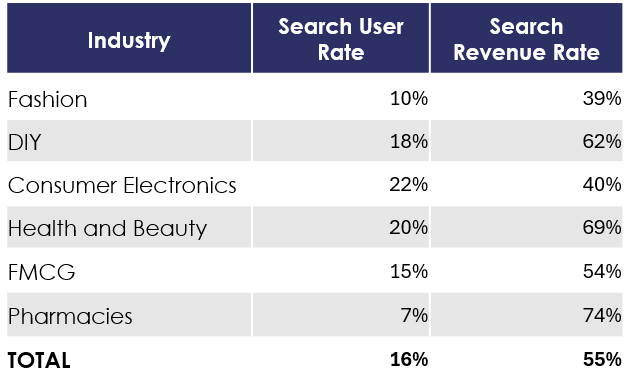Six Times the Revenue? How to Get More Out of Your Site Search on Shopify
Many believe that a well SEO-d product catalog and is enough to ensure product visibility, as Google or ChatGPT bots will handle the rest for the major search engines.
However, the real-world data tells a completely different story. Users who utilize an online store’s site search engine generate more than six times the revenue compared to those who do not.
In this article we will discuss:
– why site search is a game-changer for Ecommerce,
– data about site search usage and revenue by industry,
– why AI search is not just hype, but already a proven solution, and
– how to get all this for your Shopify store!

Site Search – A Key Element of the Customer Journey
Search is one of the most critical elements of the conversion pathway. When properly configured, it can significantly increase sales and conversion rates while reducing dropouts.
Despite this, analytics from Prefixbox reveal that only 10–30% of site visitors use the search function. The following table shows the ratios by industry, highlighting significant variation across different sectors:

The search function in online stores typically consists of the search bar in the site’s header and the corresponding search engine results page (SERP). Results can be refined with filters, and similar functionalities may appear on other pages, such as cart or category pages.
In summary, optimizing your online store’s search function is an obvious step for increasing revenue and improving conversion rates.
AI Search – a proven solution, not just some hype
The rapid advancement of artificial intelligence technologies further enhances the added value of site search engines.
You may think, “Oh, another story with the AI bullshit.” However, I will easily prove you wrong. AI Search is not a vague potential theory – these solutions are already implemented on live sites, generating revenue.
How AI Search works
Artificial Intelligence solutions enhance search engines in two main areas currently:
- Automation: AI minimizes the need for manual optimization and setup.
- Understanding User Intent: AI interprets conversational queries like, ‘I’m looking for a gaming laptop that can run GTA6.’
Most AI search solutions combine vector database technologies with large language models (LLMs). This approach significantly improves the relevance of search results compared to traditional keyword-based engines, providing more accurate and meaningful results for the shoppers
How does Vector search work? It converts products into mathematical objects (vectors) and places them in a vector space. Consequently, similar products naturally cluster together. Then, the same transformation is applied to search queries. the results closest to the query vector are displayed.
When combined with traditional keyword-based methods, vector search ensures users always get the best possible results.
Additionally, AI and LLM technologies address other challenges, such as:
- Managing Synonyms: Automatically recognizes different terms for the same product (e.g., “notebook” and “laptop”), eliminating the need for manual rules.
- Enhancing Product Descriptions: Makes them clearer and more informative.
- Chat-Like Search Support: AI-powered agents help users find what they’re looking for faster.
Case Study – 45% Increase in Revenue with AI Search
The success of AI-driven search engines is exemplified by the Prefixbox AI Search Engine, which generated a remarkable 45% increase in revenue for the Bauhaus Czech online store during the testing phase compared to a traditional keyword-based engine. Impressed by these results, the client requested an early activation of the AI Search, which has been operating successfully ever since.
Elevating Search Functionality for Shopify Stores
In mid-2021, Shopify introduced “Online Store 2.0” themes, significantly simplifying the use of third-party apps. Since then, apps can be enabled or disabled with a simple toggle within the theme editor. This eliminates the need for code injections or custom integrations, which previously made installing and removing apps more complicated.
Despite this, many stores still use outdated “vintage” themes. The issue with these themes isn’t just that apps are harder (or impossible) to install on them, but also that they’re no longer available in the official Shopify store. As a result, they don’t receive functional or security updates, making them increasingly risky to use. Transitioning from vintage themes is therefore not only strongly recommended but becoming increasingly urgent.
In the modern Shopify environment, installing third-party apps from the official Shopify App Store has become incredibly easy. These apps are excellent for enhancing store functionality with solutions developed by specialized providers. Furthermore, most apps offer free plans, allowing you to test them completely risk-free before making a long-term commitment.

The best third-party Shopify search apps
Search apps available in the Shopify App Store allow you to optimize the search bar, search results page tiles, and filters. Some applications also manage the tiles and filters on collection pages, further enhancing the overall shopping journey.
Issues with the default Shopify Search & Discovery app
The simplest choice is Shopify’s own Search & Discovery app. It’s intuitive to set up since it looks and works just like any other menu in the admin panel. Another key advantage of the Search and Discovery app is that any changes to the products are reflected instantly in the search app as well, as it pulls data directly from Shopify’s database.
However, its simplicity is also a drawback, as some of its features are quite limited. For example:
- The number of filters is limited: You can create up to 25 filters per store.
- No pagination after applying filters: the filtered results aren’t continuously loaded onto a single page.
- No search within filter values: For instance, if a store sells phone cases and creates a filter based on phone models, it will generate a long, scrollable list—but customers can’t search within it.
- Limited customization options.
- Restricted customer support: The official Shopify support team doesn’t always provide sufficiently helpful solutions.
Specialized third-party apps
This is why external, specialized site search apps come in handy. These solutions offer advanced features, full customization, and dedicated customer support to enhance the search experience.
Previously, Prefixbox focused on custom enterprise solutions for mainly mid- and large-sized businesses. However, a few months ago, Prefixbox made the site search technology available for all Shopify merchants in the App store.
With the Prefixbox AI Search & Filter app, the search bar, the search page and collection pages can all be customized directly within Shopify’s theme editor. Filters (on both the search and collection pages) can also include a mini search bar, allowing customers to search within filter values. Additionally, the system automatically displays only relevant filters based on the search query, eliminating the need for manual setup for each collection.
For more details on additional features, visit our dedicated page.
You can find the full list of available search & filter apps in this Shopify App Store category.
Summary
Optimizing an online store’s site search functionality is crucial for boosting conversions, increasing revenue and minimizing churn. Data shows that shoppers who use search generate over 6 times more revenue than those who don’t.
AI-powered search solutions, such as vector search and large language models, further enhance search performance and the user experience throughout the customer journey. These technologies not only reduce the need for manual configurations, but also make search results better and more relevant.
On Shopify, installing third-party search apps has become easier than ever with app embeds in Online Store 2.0 themes. These specialized apps allow merchants to fine-tune and customize their site search and filters, offering advanced features and dedicated customer support for a superior shopping experience.


